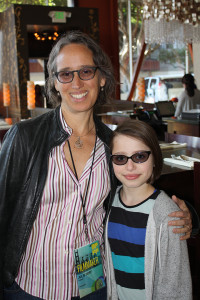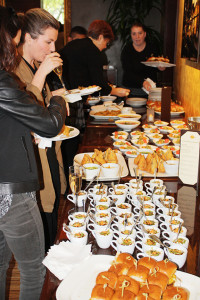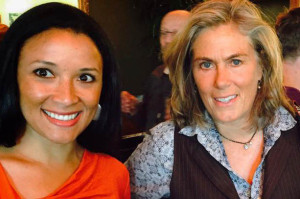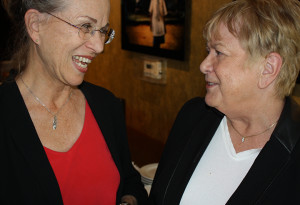In the opening moments of the film The Royal Road, Jenni Olson‘s narrative voice speaks softly against the backdrop of a beautiful scene of the San Francisco Bay: “I’m inordinately obsessed with the stories of others, seeking within them the key to my sharing my own. I want to tell you a story about love and loss and San Francisco, that reveals more about me than I ever expected to say.”

Jenni’s wife Julie Dorf with their daughter Sylvie Olson-Dorf
This is a deeply personal film that reaches out and grabs your heart. At the screening, it was so quiet in the theater that I am reluctant to crunch on my popcorn. I feel immediately connected to and very much a part of Jenni’s story. One of the scenes embraces the sunny neighborhood where I spent the ’90s with my now ex-wife raising our two young sons in SF’s Mission District. While the camera lingers, the sweetness and joy of remembering that period of my life washes over me. This is the kind of experience Jenni allows for with her quiet, steady storytelling. She makes a case for defending nostalgia, thereby encouraging us to remember and claim our own stories about the places we have lived and loved.
Last week, Epochalips’ staff writers Jan Corran and Renate Stendhal and I had the good fortune of attending the San Francisco premier party for Jenni’s exciting new Sundance selected experimental film. Munching delicacies at the popular Indian Fusion restaurant Dosa across from the Kabuki Theater, we mixed and mingled before the screening. Jenni stood at the front door warmly welcoming everyone who jammed into the packed room. In attendance was Jenni’s lovely wife Julie Dorf. In addition to her role as producer of The Royal Road, she is senior advisor at the Council for Global Equality and a longtime international LGBT human rights advocate.

The Spread at Dosa
I have always respected Olson’s work and knew it would be a good film. From the opening scene to the Q & A after the film, the audience was captivated. Not one person left until it was all over. Long, lingering shots on 16mm film framed Jenni’s compelling narrative. It was thought-provoking and real, giving space for the viewer to draw their own conclusions. The Royal Road is not only the story of a cute butch woman’s longing for love, but also a story “In Defense of Nostalgia†and a lesson in California history. Filmed in San Francisco, Los Angeles and along Camino Real, it weaves in the tragedy of the Mexican-American War, and educates us in the process about all these things. Beautiful and poignant, I could see it again and again.
From Jan Corran:
Who knew that the long and winding road named Camino Real would be the backdrop for a journey of self-reflection and inner exploration for filmmaker Jenni Olson. Royal Road is a labor of love with its quiet and beautifully shot scenes that mesmerize and entice us. Jenni just may have discovered the road to enlightenment.
From Renate Stendhal:

Rachel Robasciotti (left), and Robin Lowey
In front of her audience, Jenni seems the archetype of the shy, brilliant boy-butch, charmingly understated, self-ironic and funny. She gestures vividly to get something complicated across, and while her new film is filled with sophisticated thoughts and complicated feelings, it could sail under the simple tag-line: “I lost my heart in San Francisco.†The Royal Road is a self-portrait in images of the city – a double portrait, one could say. The filmmaker described it in an interview as “a lyrical new film contemplating butch lesbian desire, nostalgia, Casanova, a history of the Mexican-American War and so much more.â€
How to describe a film that is really a poem? Accompanied by Jenni’s narrative in her appealingly cracked voice, the Royal Road is otherwise silent, inviting us to a contemplation. We see streets and alleys of the city, roofs and skylines with clouds and birds, cars and ships quietly moving past the camera. I didn’t notice a single tourist vista or “money shot†in this portrait of San Francisco. The images are personal “takes†on the mysterious, alluring, wind-swept beauty of the place. They come at a slow, poetic pace while the narrative smoothly winds back and forth between past and present, memory and forgetting, love and longing, the personal and the political.

Renate Stendhal (Left) and Jan Corran
There is the real Camino Real, “the historic 600-mile (966-kilometer) California Mission Trail, connecting the 21 missions, 4 presidios, and 3 pueblos, stretching from Mission San Diego de Alcala in San Diego in the south to Mission San Francisco Solano in Sonoma in the north.†(Thank you, Wikipedia.) She remembers what “Americans don’t like to rememberâ€: the meaning of these missions for the American Indians and the brutal Mexican-American War that allowed the United States to grab half of Mexico and call it California at the end of the day.
But essentially, for the filmmaker, the royal road is the road to the heart, to the lovers she pursues, courts, and keeps longing for, while “nothing is ever happening.†Like a music in minor key, there is a tone of yearning, regret and tender self-irony. Torn with desire to kiss a woman, for example, Jenni ponders which natural catastrophe might justify such a move – an earthquake perhaps?
The road, divided into chapters, first takes her down the historic Mission Trail to LA, to the first of several adored would-be lovers, and the first of several movie classics is remembered: The Children’s Hour, recalling the filmmaker’s early intuition of being queer, before she had any knowledge of her nature. Other women follow, every one of them ardently longed for, and Jenni remembers Roman Holiday as one of the great examples of unfulfilled romance. One of the chapters is called “In Defense of Nostalgia,†which made the audience laugh, and rightly so. The entire film celebrates nostalgia. Jenni sees San Francisco as the place where things she loves and has loved for a long time, are disappearing almost as she is looking on. Holding them in the eye of her camera, holding still, then becomes her way to stop time, to possess the desired place outside of time and change.
It is no surprise that Hitchcock’s Vertigo appears in The Royal Road as a chosen symbol because of the classic film’s obsessive connection between San Francisco, the past, love and loss, and moviemaking. Living in San Francisco, Jenni says, “is like living on the virtual set of Vertigo.†She muses that the heroine of Hitchcock’s film is called Madeleine: could that be an allusion to Proust’s madeleine, the famous key to memory? Bringing the mythical to her own journey with a self-ironic twist, she asks which archetype of great male lovers she might resemble: Lothario, Don Juan, Romeo, or Casanova? She decides for Casanova. Casanova was warned never to tell the truth on the “royal road†of writing his adventures. The warning, the filmmaker notes, came too late: the story had already been told.
See upcoming Screenings of The Royal Road at:
QDoc (Portland) — May 14-17
Seattle International Film Festival — (May 14-June 7)
Inside Out Toronto LGBT Film Festival — May 21-31
More about The Royal Road here: royalroadmovie.com  Twitter  Facebook
—————————————————————————————————————————————————————
Like this article? Sign up here for our amazing Epochalips eMagazine and we’ll keep you up to date on what’s new and exciting in our world!



I love your blog.. very nice colors & theme.
Did you design this website yourself or did you hire someone
to do it for you? Plz respond as I’m looking to create my own blog and
would like to know where u got this from. cheers
WordPress!